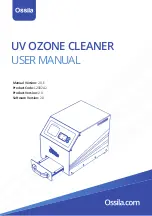
51396c GB/2019-04
17 / 27
1
electronic GmbH & Co. KG • Heinrichstraße 3-4 • 12207 Berlin • Deutschland • [email protected]
Step 2:
Degassing the
fl
uid
Freshly-
fi
lled bath
fl
uid or
fl
uid that has remained in the oscillating tank for a longer
period of time must be degassed prior to use. See also chapter 4.3.1.
Remove the basket from the oscillating tank.
Place lid on top.
Turn on the ultrasonic bath.
For degassing, set the time 10 min and start the ultrasound (Press START/STOP
button for 2 sec), see chapter 3.1.1 and 3.2.
Time need to be extended with acidic cleaning solutions.
Step 3:
Preheat
fl
uid
In ultrasonic baths with built-in heating, the
fl
uid may be preheated independently of
the ultrasound. This increases the ultrasound effect, especially when removing fats, oils
and polishing paste residue, and shortens the duration of the subsequent ultrasound.
Remove the basket from the oscillating tank.
Place lid on top.
Set the desired temperature, see chapter 3.1.2. The ultrasonic bath begins heating
immediately.
Step 4:
Insert objects to be treated
Before every sonication it is necessary to check whether the bath
fl
uid needs to be
cleaned or replaced.
Place soiled parts such as pipettes in the delivered basket with the tips pointing
downwards.
- The basket prevents damage to the objects to be sonicated and to the bottom.
- Overloading the basket will reduce the ultrasound effect.
- Air must be able to escape from hollow areas.
Verify that the objects to be treated are fully covered by
fl
uid.
Place lid on top.
Step 5:
Ultrasound – operation
Fundamentally, the sonication time is to be set as short as possible in order to protect
the parts to be treated and the oscillating tank.
In the case of stubborn residue, conduct sonication for a longer time if necessary.
Set the required sonication time and start the ultrasound, see chapter 3.1.





































